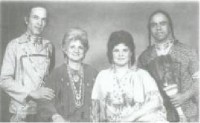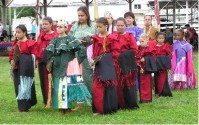Native Pride

Key Leaders during Tribal Reorganization in New Jersey
In the 1960’s and 1970’s, a new generation of tribal leaders arose that began to advocate for our tribal communities in ways that were more outspoken and public. While the Nanticoke Community of Sussex County, Delaware, had re-established a tribal chieftaincy in the early 1900’s, the church based, family clan style governance that had prevailed for almost two centuries within the more northern communities in Kent County, Delaware, and Cumberland County, New Jersey, was supplemented with non-church based community action initiatives and then was slowly replaced with constitutionally reorganized tribal governments. The quiet self isolation of the past began to give way to a more activist style of leadership, which began to regularly interact with the non-Native public on behalf of the tribal people.

Nanticoke-Lenape Children performing a traditional dance
By 1978, tribally controlled community benefit charities were established to provide social services to tribal citizens. Cultural programming sought to ensure the preservation and promotion of tribal culture. Regular meetings of the tribal citizenship moved from principally being in the churches to being conducted in community facilities. Offices were established and staff was hired to administer tribal programs.
Annual Pow Wows, which are celebrations of American Indian Culture and are marked by drumming, dancing, eating, and the display and sale of crafts, were opened to the public.
In 2007, the Nanticoke Lenni-Lenape Tribal Nation of New Jersey and the Lenape Indian Tribe of Delaware formed the intertribal union, “The Confederation of Sovereign Nentego-Lenape Tribes,” aimed at promoting tribal interests, preserving tribal culture, and protecting tribal sovereignty.
